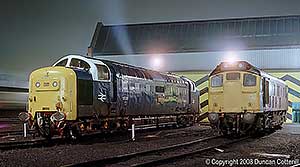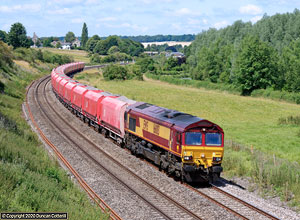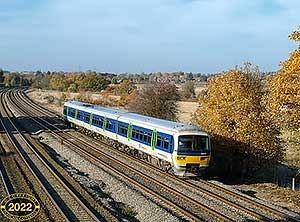Industrial Railways
4 photos
updated : 2015-07-08
Industrial railways were once a very visible part of the British railway scene but most have closed along with the heavy industries they served. The few that remain are often inaccessible in high security environments, such as oil refineries or steelworks. These shots are from Bedlay Colliery in 1981.
Steam
8 photos
updated : 2023-04-23
Real working steam has been a priority for me and that hasn't been available in the UK since the last industrial systems closed or dieselised in the early 1980s, just as I was getting started. Although preserved steam feels a bit artificial to me, I do point my camera in the direction of a steam special, occasionally.
Electrics
36 photos
updated : 2023-10-19
There aren't many electric locos in 21st Century Britain. The almost complete eradication of loco hauled passengers and the lack of joined up freight routes mean there's only enough work for a few dozen locos, and recent years have seen a reduction in their use despite the operational and environmental benefits.
High Speed Trains
378 photos
updated : 2024-02-21
Originally high speed trains meant HSTs, or InterCity 125s as they were better known, but the category has grown to include Class 91 powered InterCity 225s and various types of high speed DMU, EMU or BMMU. This gallery includes all high speed trains, defined here as unit trains capable of 125mph or more.
Bi-Mode MUs
66 photos
updated : 2024-02-21
This category covers units with bi-mode capabilities, generally the ability to run as EMUs on electrified lines and switch to diesel engines or batteries elsewhere. Over 100 such units, almost unknown in the UK until recently, are in service already and many more are expected to be built in the coming years.
Electro-Diesels
44 photos
updated : 2024-02-25
Electro-Diesels are electric locomotives that also have a diesel engine to provide power away from electrified lines. The 750V DC Class 73s have been in use since the 1960s and have recently been joined by new 25kV Class 88s. With Classes 93 and 99 also on order the future for electro-diesels looks bright.
Classic Traction
226 photos
updated : 2024-02-27
This gallery contains pictures of British Rail's diesel and electric loco classes introduced before 1980, including later rebuilds such as the Class 57s and 69s. These were the locos I grew up with, travelled behind and collected the numbers of as a teenager and cut my teeth on as a photographer.
Loco Hauled Passenger
187 photos
updated : 2024-02-29
The loco hauled passenger train is a real rarity in the UK these days but it wasn't always so. The word "passenger" has been loosely interpreted to mean trains formed of coaching stock including parcels and mail trains as well as empty stock workings, test trains and unit drags. HSTs and similar are excluded.
Freight
1075 photos
updated : 2024-02-29
Freight traffic declined steadily through the BR years despite numerous initiatives to stem the tide. There was an upturn post-privatisation but the decline in coal-fired power generation hit the sector hard. Fortunately other markets such as intermodal and aggregates are helping to fill the gap.
EMUs
299 photos
updated : 2024-02-29
Electric Multiple Units have run in Britain for over a hundred years and will probably be the dominant form of traction for the next century. They come in many variants, designed for everything from urban mass transit to high-speed, long-distance, InterCity travel and carry a wide variety of liveries.
DMUs
349 photos
updated : 2024-02-29
Diesel Multiple Units have been a significant part of the British railway landscape since the modernisation plan units first appeared in the late 1950s. Their use has since expanded from local and suburban services to almost all passenger trains on non-electrified lines, including long-distance expresses.
My home country where I've been photographing trains since the late 1970s. Only a small fraction of my British material is online at present but it covers a wide range of loco classes, train types and photo locations, from northern Scotland to the south coast of England and from Deltics to DMUs.
Britain's railways are far less interesting than they were a few decades ago but despite the decline it is still possible to find trains and locations that are worth photographing.




 options
options hide options panel
hide options panel













